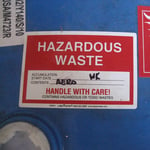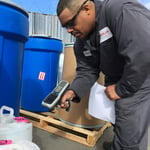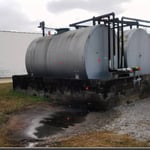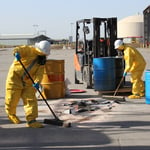The EPA is charged with enforcing environmental regulations to assure compliance. Fines are levied when there are violations, and they are most often related to improper storage, incorrect labeling, exceeding capacities, failure to take corrective actions to fix issues, and creating an effective waste management plan.
Below are the six most common environmental regulatory violations that have been identified by our teams across the country. We’ve also included how you can assure compliance so your business is not exposed to unexpected costs.
The 6 Most Common EPA Violations
1. Improper containers

Not using the correct containers or using containers incorrectly is one of the most common waste violations, yet it is also one of the easiest to avoid.
This violation occurs when hazardous waste is stored in an open container, in a container that is in poor condition, in a container too small for the waste inside it, or when the container is not secured.
2. Inadequate aisle space

A hazardous waste container storage area must have enough aisle space to allow for the unobstructed movement of personnel and emergency equipment.
Although the amount of required space may change based on the specific type of waste, the EPA generally defines adequate aisle space as two and a half feet.
3. Incorrect labeling, including misclassified waste and omitting the start date

The EPA outlines specific rules for labeling the various types of hazardous and non-hazardous waste.
The first step to avoiding this violation is to classify your waste correctly. The classification must be clearly visible on the container, along with the start date of accumulation in the container and DOT markings and labels required.
4. Waste generation volumes exceed the generator capacity category, including storage limits and/or monthly volumes

Hazardous waste generators are restricted in the amount of waste they may create by their storage and/or monthly volume limitations. This common violation can be avoided by properly tracking how much waste material you produce, adjusting your operation to ensure you don’t exceed your limits, and assuring the waste is transported away from your facility to free up space at necessary intervals. Don’t wait until you are at capacity – have a plan in place to schedule waste pickups with at least a week to spare before you anticipate your waste limit will be reached.
5. Corrective actions are delayed

Regular inspections are a critical aspect of properly managing, storing, and transporting hazardous waste. If a problem is discovered, corrective action must be taken as soon as possible. Failure to do so can result in additional fines.
You must also document the corrective action and include the issue being corrected, the person responsible for the correction, and the date and time.
6. Plans are not updated when operational changes are made

Whenever you make changes to your operation or hazardous waste management process, you must also update your facility’s emergency response and contingency plans.
If your plans do not accurately correspond to your current operation, your business can incur additional fines.
EPA violations can be expensive
Environmental regulatory violations can often accumulate, and fines can be high. One example is a large quantity generator that was inspected by the EPA in early 2020. It is a relatively small company with fewer than 75 employees that has a manufacturing and warehouse facility.
They manage spent solvents and some caustic wastes onsite. During the inspection it was found that the waste was not being properly stored. What made matters worse is that they were storing the hazardous waste onsite for more than 90 days, which caused the EPA to classify them as a TSDF (treatment, storage, and disposal facility) operating without a permit instead of a large quantity producer. That classification opened them up to a wide range of additional violations.
The EPA charged them with 15 violations, from lack of aisle space and improper labeling, to leak detection, failing to update the emergency plan, container issues, and more. The total fine was $255,344, a large amount for a relatively small company.
How to avoid EPA waste violations
There are two primary ways to avoid EPA violations and the associated fines. The first is to train everyone at your company who may come into contact with your waste on all the relevant rules, regulations, plans, and best practices, including everyone from the maintenance staff to the management. That process can be onerous and requires an extensive amount of time and effort and relies on non-waste experts to understand the finer points of the regulatory environment.
Another option is to hire an environmental services company to assist you in dealing with the liability of managing and disposing of your waste. Third party waste management companies handle:
- Document monthly inspections to review space, containers, and labels
- Define each waste stream process
- Review waste information profiles (WIP) for accuracy and kept up to date
- Assure documentation and review for:
- Containers
- Volumes and contents
- Dates
- Labels
- Records
- Aligning plans with operations
- Emergency response and contingency plans
- Conduct employee training
Experts handle your waste, ensure compliance, and offer guidance if any violations do occur. Hiring an outside hazardous waste management company is the surest, most efficient way to avoid costly violations and fines.



